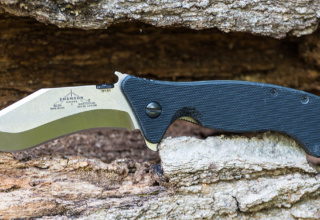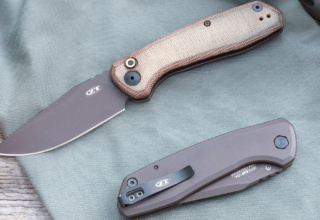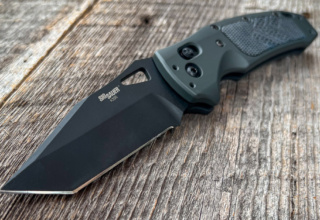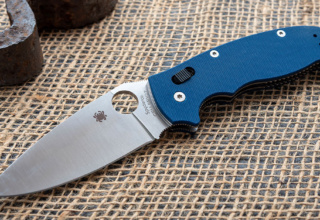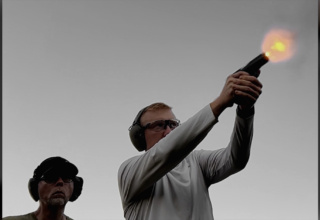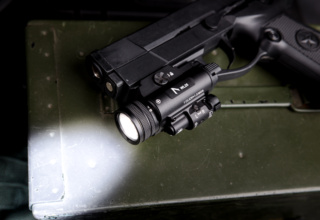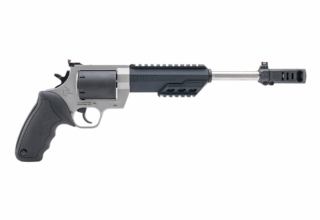There’s no better pairing for a personal defense firearm than a quality tactical knife. Here, we present the basics of tactical knife construction and design, and explain what you need to know before making the investment.
by Dexter Ewing; photos by Marty Stanfield, Marty Stanfield Photography
Most defense-minded folks—even those who are new to firearms and exercising their personal defense rights—have likely noticed the increasing popularity and focus on tactical knives. These are brawny, rugged tools that are designed and built to withstand hard use in multiple environments. You can think of the tactical knife as the 4WD truck of blade world. Four-wheel drive trucks can be found in law enforcement, fire departments, in the military, on construction sites, the ranch, and in the city. The same goes for tactical knives.
A popular misconception is that these knives are intended exclusively for law enforcement, EMT, military, and fire department personnel use. Nothing is further from the truth. They are for anyone who needs a ruggedly built folding knife or fixed blade that will withstand harsh environments and hard use. What’s more, tactical knives can be purchased by anyone.
The purpose of this article is to provide an introductory course, of sorts, in tactical knives. We’ll start with a little history on the tactical knife trend, which will give you a greater understanding of and, hopefully, appreciation for this genre of knife.
Tactical Knife Background
The tactical knife genre as we recognize it today is over 20 years old and still going strong. The trend emerged from the production knife market. At that time, the knife market was radically different than it is today. Hunting and outdoor knives were the major trend back then, and they still are despite being seemingly overshadowed by tactical knives.

As tactical fixed blades and folding knives gradually appeared on the market in the mid-1990s, their popularity gained serious traction. Sales climbed sharply upward by the late-1990s. About that time, the naysayers came out of the woodwork, dismissing tactical knives as just another trend or fad that was sure to meet a premature demise.
Now it is late 2020 and tactical knives are STILL a hot trend and they have even carved out their own market category within the knife industry. With at least two solid decades of popularity, tactical knives are not to be ignored.
Answering the Many Questions
You decided to purchase your first tactical knife but are unsure how to go about it. First, you need to decipher what your primary use of the knife will be. Do you want a folding knife that you can carry with you every day? Do you have a job that requires having a durable knife (carpenter, electrician, plumber, construction worker, landscaper, etc.)? Do you plan to carry the knife with you on camping trips? On the farm? Do you want it for your first-responder job? What’s your budget? Do you mind paying a bit more for a better product made with better materials or do you want a value knife that’s relatively low cost yet well made?
Tactical knives fall into one of two categories: folding and fixed. We’ll look at the different characteristics that you need to be aware of among these categories. This way, you can shop smarter for the knife that best suits your needs and budget.
Blade Shape
The first thing that you want to pay attention to is the blade shape. If your primary use for the tactical knife is general, everyday use and you need a knife that’s going to be utilitarian in nature, then you want to look for the more common blade shapes such as a drop point, clip point, or spearpoint. These blades handle slicing jobs very well and can cut through a variety of materials that are found on the job site, farm, or around the home. These blade shapes are also easy to sharpen, should you plan to do your own knife maintenance.

There’s also the Japanese-inspired Tanto blade shape, with its distinctive angular blade tip with the secondary edge. Tanto blades come from the medieval Japan era, where swords had the ability to pierce through armor and other thick materials. Tanto blade are certainly “tactical,” and while they look aggressive due to the angular shape, they can be a bit tricky to sharpen regardless of the blade material. But, if your primary purpose for a tactical knife is self-defense, a Tanto is a great blade shape to choose.
Blade Length and Material
Generally, a knife with a 3- to 3.5-inch blade is good for everyday carry. The blade shape is large enough to tackle most cutting tasks but remains compact enough to be carried comfortably. If you’re going for the entry-level to mid-grade tactical knives, you’ll likely encounter the following blade steels: AUS-8, 8Cr13MoV, 420HC, 440A, or even BD1. These steels are typically inexpensive to acquire and work with by the manufacturers and, therefore, they can pass the savings on to the consumer. They all hold an edge fairly well and are easy to resharpen.
AUS-8 and 8Cr13MoV are steels of Asian origins and are found on most knives that originate from China or Taiwan. The rest, while they also are found on knives originating from Asia, can be found on knives that are made here in the USA. Asia, though, has a stronghold on knives in the entry level range due to the low cost. Companies can have knives manufactured in China or Taiwan and still obtain the manufacturing quality they are looking for but at a fraction of the cost than if they were manufactured here. Like it or not, it’s just the economics of manufacturing.

Higher-end knives are where the distinction in materials is greatest when compared to entry-level knives. Blade steels for the higher-end knives hold an edge over time, making them more expensive. Prime examples of high-end blade steel are: 154CM, CPM154, CPM-S30V, CPM-S35VN, and CPM-20CV. The CPM steels are harder steels and thus are more wear resistant. There is, however, a trade-off. These steels are more difficult to resharpen (because they are wear resistant) and take more time to get sharp than the lower grades of stainless steel.
Serrated Blades
You’ll notice some tactical fixed-blade and tactical folders come with the option of partially serrated blades. You will have a little section of toothy serrations that will help the blade to power through tougher materials like cardboard, hose, webbing, thinner plastic, and such. If you do a lot of cutting of tough, fibrous materials, then you might consider the part-serrated blade. Part-serrated blades also seem to be a love it or hate it proposition, with those who own them appreciating the option of having, in essence, two blade styles in one blade. Others who do not prefer these blades say the run of serrations ruins the look of the blade and that sharpening serrations can be difficult. (NOTE: Serrated blades are not that hard to sharpen as long as you purchase the right sharpener).
Knife Handles
Handles are another key factor when selecting a knife. The handle is the “user interface.” Regardless of the size, shape, or handle material, the bottom line here is COMFORT. Simply put, if the handle isn’t comfortable, then the knife will not get used and is pretty much useless to you.
Tactical knives are NOT typically used in an office setting. They are used outdoors, in varying weather conditions (searing heat, freezing cold, when hands are sweaty, bloody, or in the rain). Two factors of handles to consider are the actual design of the handle plus the handle material, as both work in harmony to provide an ultra-secure, non-slip grip for all conditions.

Synthetic handle materials are best for tactical knife use. Why? They are impervious to most fluids, are lightweight, resist temperature extremes, and offer a good tactile grip. This is where phenolic-based materials are best.
G-10 is a composite phenolic-based material that uses layers of fiberglass cloth bonded together by a resin, resulting in a lightweight yet strong material. G-10’s standard color is black, but there are other colors like blue, red, OD green, tan, and even dual-colored G-10 with alternating layers of blue and black, red and black, orange and black, and so on. The idea here is when the handle material is contoured for better fit to the hand, the alternating layers come out with a woodgrain-type visual effect.
Micarta is another popular choice in handle material. It is made in similar fashion to G-10. There are three types of micarta based on the type of cloth used to make the material. You have paper micarta, linen micarta, and canvas micarta. The most common of these three is linen micarta. This gives a good grip quality and is easy to work with from a manufacturing standpoint. Canvas micarta uses thicker and more coarse material and thus has a grippier quality to it but the finish isn’t as refined as linen micarta. Canvas is really for “user knives,” such as tactical fixed blades. Micarta also comes in a wide array of colors as well as standard black, such as brown, OD green, red, blue, etc.
With tactical folding knives, not only do you have the above-listed handle options, but others as well. Aluminum is a great choice for a handle material because it’s lightweight yet very rigid and it can be machined to incorporate handle texturing like checkering or traction notches on the handle spine for additional grip retention.
More Considerations
With fixed blades, be sure there is some sort of forward hand guard to prevent your hand from sliding forward during use. Most advanced design tactical fixed blades will not only have some sort of forward hand guard, they may also incorporate some swelling of the rear of the handle to prevent rearward sliding.
The more ergonomic a handle is the more comfortable it will be. Some fixed blades may have a palm swell in the middle of the handle to fill your grip, making the knife feel more comfortable in-hand.

Another area of importance is the sheath. There are two styles of sheaths for tactical fixed blades. First is the ballistic nylon sheath, which is sewn and riveted together using heavy-grade ballistic nylon fabric. There is a plastic liner inside the sheath which not only gives structural rigidity to the sheath but also protects the sheath from being cut by the blade. These ballistic nylon sheaths may incorporate a small pouch with a Velcro flap closure. This utility pocket can accommodate a folding knife, multitool, or a small sharpener for convenience. Ballistic nylon sheaths are available in a wide array of colors, from black to tan, OD green, and camo.
The second popular style is a form-fitting, molded Kydex sheath. The Kydex sheet is molded to the shape of the knife so that when the blade slides in, the sheath locks around the base of the handle, securing the sheath to the knife. These types of sheaths can be carried via MOLLE straps or some sort of belt loop.
The downside to Kydex sheaths is that they can be noisy if they are hit against something or when the blade is inserted and, due to their form-fitting nature, any grit in the sheath could scratch the blade as its moved in and out.
One material you will never see on modern tactical fixed blade knives is leather. While leather looks better than ballistic nylon or Kydex, leather will absorb moisture and eventually come apart.

Lower-end fixed-blade tactical knives may have sheaths molded from plastic, which are OK. Most sheaths of this type leave a lot to be desired and are usually flimsy. It’s all about hitting price points for manufacturers so they must consider what is the best material to use for a particular knife’s price point.
Tactical Folders
As far as tactical folding knives are concerned, there are some factors that are specific to folders that you also need to take into consideration.
First, you might have noticed that a lot of the modern, single-blade folders have some sort of pocket clip attached to the handle. This negates the use of a belt sheath to carry the knife. The pocket clip allows you to insert the closed knife into the pocket and use the clip to secure the knife to the pocket, allowing it to ride at the top of the pocket. It will sit there without moving around, and the handle is easily accessed when the knife is needed. Otherwise, it stays out of the way.
Pocket clips carry a folder in the blade in a blade “tip up” or a blade “tip down” orientation. You might find one of these more advantageous over the other based on how you grip the knife when you withdraw it from the pocket and how you thumb open the blade. Should you have folders that are both tip up and tip down carry in your collection, you’ll discover that you can deploy the blade easily regardless of the configuration.

If you’re a lefty, you know very well what it is like to live in a “righty” world. There are some manufacturers who offer another set of clip mounting holes on the opposite side of the handle, allowing you to switch the clip and make the knife left-hand-friendly. Some knives offer what is called four way-mounting, meaning there are four sets of clip holes on the handle so you can have your choice of either tip up or tip down carry or left-hand or right-hand carry. All you need is to have the appropriate driver to remove and re-insert the tiny clip mounting screws. Usually, this is a T6 sized Torx driver. Should you break the clip or spring it out, you can remove the clip for replacement or carefully bend it back to shape.
Locking Mechanism
Another thing to consider with folding knives is that most of them will have some sort of blade lock, which secures the blade in the open position to prevent it from closing on your hand during use. The two most common blade locks are the lockback and the liner lock.
The lockback uses a metal lock inlaid into the spine of the handle and is held under spring tension. On the end closest to the blade, there is a tooth that engages a slot in the tang. On the opposite end, near the rear of the handle, you press down on the end of the lockbar to lift the tooth out of the slot in the blade tang. When the tooth is in the slot, the blade is locked. Usually, two hands are required to close the blade—one hand unlocks it and the other hand rotates the blade closed.

A liner lock is a bit more involved. The lock is cut out from the metal liner of the knife handle (a liner adds structural rigidity to the handle). The lock bar is bent so that it wedges itself onto the tang of the blade, preventing the blade from rotating closed. Unlocking and closing the blade requires only one hand. Grasp the knife handle firmly and place your thumb into the cutout of the handle, which exposes the liner lock bar. Press the lockbar all the way in while placing your index finger on the spine of the blade and gently pushing the blade towards the channel of the handle. Once the blade has begun its closing rotation, the thumb can be removed from the lockbar and the blade allowed to continue to rotate into the handle to its fully closed position. Be mindful of where your thumb is located, as it is fairly easy to get accidental cuts from the moving blade.
Aside from lockbacks and liner locks, there are also other styles of blade locks, such as the Benchmade Axis Lock and Hogue ABLE Lock—both of which use a spring-loaded lock bar inset into the handle that slides back and forth, thus securing the blade tang in the open position. None of your fingers cross the path of the closing blade, therefore, this method is a bit safer than the lockback and liner lock designs and is, perhaps, easier to manipulate than both.
There’s also a button lock, which is commonly found on most automatic opening folders and some manual opening folders. The button lock uses a tapered plug mechanism that secures the blade open. Pressing down on the button causes the tapered plug to release from the corresponding notch in the blade tang, allowing free rotation of the blade.
Next, there is the frame lock, which operates on the same principle as the liner lock except the lockbar is cut or bent from the titanium handle slab of the folder. The lock, in this case, is integral to the handle. Frame locks are preferred by many because of the increased lock thickness over a standard liner lock.
So, having some sort of rugged and reliable blade locking mechanism is imperative for a tactical folder due to the nature of how these knives are used.

The Price to Play
Regarding cost, all “value-priced” tactical knives are made overseas, usually in China. Typically, these knives offer a high quality of manufacture using lower end materials. Expect to have lower-grade stainless steel for blades and some sort of molded, reinforced thermoplastic handles. You’ll find some aluminum or G-10 handles in the mix as well.
As you increase in price, you’ll still have China-made knives, but you might start seeing some from Europe (Germany or Italy) as well as some that are made in the USA.
At the higher end of the spectrum is where you will find the best blade and handle materials. You’ll find a lot of USA companies in this rank, along with some from China, Germany, and Italy. The knife market really is global. Some enthusiasts prefer to only buy those knives made in USA, which is fine. Just know you are excluding some well-made knives coming from other countries. There’s just no set rule other than to buy what you like.

If you are hunting for a knife that you can use hard, put up wet, and that will withstand all that you can put it through, look no further than a quality tactical knife. Obviously, there are limitations to what these knives can do. The same rules for knives in general apply here: do not use as a pry bar, screwdriver, or hammer. If you need such tools, then get and use them. Knives are made for cutting.
Tactical knives, be they folders or fixed blades, come in all sizes and prices, so be sure to shop around and match the knife to your needs and budget. Buy the best you can afford, and you’ll have a sturdy companion for years to come.


